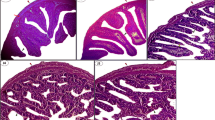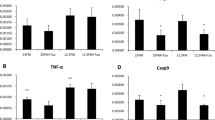Abstract
Aquaculture is faced with the challenges of the use of synthetic compounds as growth enhancers and the presence of several contaminants in water. These factors severely deteriorate the quality and quantity of aquaculture products. Phytochemicals play a major role by working as antioxidant agents of which curcumin has become the gold standard. Curcumin, from Curcuma longa shows a wide spectrum of biological activities which include anticancerous, antioxidant, anti-inflammatory, antibacterial, antiviral, antifungal, antidiabetic, antistress, hepatoprotective and gastroprotective effects. Curcumin in 0.5 and 1 % doses were given as feed additive to Oreochromis mossambicus for 35 days. After feeding trial, activities of digestive enzymes such as α-amylase, protease and lipase were analysed. There was a significant increase in the activities of α-amylase, protease and lipase with 0.5 and 1 % curcumin supplementation in feed. Real-time quantification of GH in brain, and IGF-1 and IGF-2 genes in muscle revealed that curcumin significantly increased the expression of these genes. This is the first study to report that curcumin supplementation at concentrations of 0.5 and 1 % in the feed improved the activities of digestive enzymes and also modulates the expression of GH in brain and growth factors such as IGF-1 and IGF-2 in muscle of O. mossambicus.



Similar content being viewed by others
References
Allen PC, Danforth HD, Augustine PC (1998) Dietary modulation of avian coccidiosis. Int J Parasitol 28:1131–1140
AL-Sultan SI (2003) The effect of Curcuma longa (turmeric) on overall performance of broiler chickens. Int J Poult Sci 5:351–353
Bernfeld P (1955) Amylases α and β. Methods Enzymol 1:49–158
Bradford MM (1976) A rapid and sensitive method for the quantification of microgram quantities of protein utilizing the principle of protein-dye binding. Anal Biochem 72:248–254
Cek S, Turan F, Atik E (2007) The effects of gokshura, Tribulus terrestris on sex differentiation of guppy, Poecilia reticulata. Pak J Biol Sci 10:718–725
Chakraborty SB, Horn P, Hancz C (2014) Application of phytochemicals as growth-promoters and endocrine modulators in fish culture. Rev Aquac 6:1–19
Citarasu T (2010) Herbal biomedicines: a new opportunity for aquaculture industry. Aquac Int 18:403–414
Cui H, Liu B, Ge X, XiE J, Xu P, Miao L, Sun S, Liao Y, Chen R, Ren M, Zhou Q, Pan L (2013) Effects of dietary curcumin on growth performance, biochemical parameters, HSP70 gene expression and resistance to Streptococcus iniae of juvenile Gift Tilapia, Oreochromis niloticus. Isr J Aquac 66:986–996
D’Souza HP, Prabhu HR (2006) In vitro inhibition of lipid peroxidation in fish by turmeric (Curcuma longa). Indian J Clin Biochem 21(2):138–141
Duncan DB (1955) Multiple range and multiple F test. Bio metrics 11:1–42
El-Bakary NER, El-Gammal HL (2010) Comparative histological, histochemical and ultrastructural studies on the proximal intestine of flathead grey mullet (Mugil cephalus) and sea bream (Sparus aurata). World Appl Sci J 8:477–485
Elizabeth K, Rao MNA (1990) Oxygen radical scavenging activity of curcumin. Int J Pharm 58:237–240
FAO/WHO (2014). State of world fisheries and aquaculture. FAO Fisheries and Aquaculture Department, Rome
Fernandez-Navarro M, Peragon J, Amores V, De La Higuera M, Lupianez JA (2008) Maslinic acid added to the diet increases growth and protein-turnover rates in the white muscle of rainbow trout (Oncorhynchus mykiss). Comp Biochem Physiol C 147:158–167
Francis G, Kerem Z, Makkar HPS, Becker K (2002) The biological action of saponins in animal systems: a review. Br J Nutr 88:587–605
Furne M, Hidalgo MC, Lopez A, Garcia-Gallego M, Morales AE, Domezain A, Domezaine J, Sanz A (2005) Digestive enzyme activities in Adriatic sturgeon Acipenser naccarii and rainbow trout Oncorhynchus mykiss. A comparative study. Aquaculture 250:391–398
Gabillard JC, Kamangar BB, Montserrat N (2006) Coordinated regulation of the GH/IGF system genes during refeeding in rainbow trout (Oncorhynchus mykiss). J Endocrinol 191:15–24
Gatlin DM III (2002) Nutrition and fish health. In: Halver JE, Hardy RW (eds) Fish nutrition. Academic Press, New York, pp 671–702
Goda AMA-S (2008) Effect of dietary Ginseng herb (Ginsana G115) supplementation on growth, feed utilization, and hematological indices of Nile Tilapia, Oreochromis niloticus L., fingerlings. J World Aquac Soc 39:205–214
Hardy R (1980) Fish feed formulation. Lectures presented at the FAO/UNDP Training course in fish feed technology, University of Washington, Seattle, 1980, pp 233–240
Harikrishnan R, Balasundaram C, Heo M-S (2011) Diet enriched with mushroom Phellinus linteus extract enhances the growth, innate immune response, and disease resistance of kelp grouper, Epinephelus bruneus against vibriosis. Fish Shellfish Immunol 30:128–134
Houlihan DF, Hall SJ, Gray C, Noble BS (1988) Growth rates and protein turn over in Atlantic cod, Gadus morhu. Can J Fish Aquat Sci 45:961–964
Hu ZZ, Yang JF, Tan ZJ, Hao JL (2003) Effect of curcumin on the growth and activity of digestive enzyme in grass carps (Ctenopharyngodon idells). Cereal Feed Ind 11:29–30
Humbel RE (1990) Insulin-like growth factors 1 and 2. Eur J Biochem 190:445–462
Johnson C (2004) Influence of certain plant extract on growth and metabolism of teleosts (Anabas testudineus and Labeo rohita) and a mammal (Rattus norvegicus). PhD thesis, University of Kerala, Thiruvananthapuram, Kerala, India
Jones JI, Clemmons DR (1995) Insulin-like growth factors and their binding proteins: biological actions. Endocr Rev 16:3–34
Keay L, Moser PW, Wildi BS (1970) Proteases of the genus Bacillus II Alkaline proteases. Biotechnol Bioeng 12:213–249
Kelloff GJ, Crowell JA, Steele VE, Lubet RA, Malone WA, Boone CW (2000) Progress in cancer chemoprevention: development of diet-derived chemopreventive agents. J Nutr 130:467S–471S
Kurhekar J (2013) Curcuma longa and Allium sativum as prebiotics. Bionano Front 6:327–329
Lee KJ, Dabrowski K, Sandoval M, Miller MJS (2005) Activity guided fractionation of phytochemicals of maca meal, their antioxidant activities and effects on growth, feed utilization, and survival in rainbow trout (Oncorhynchus mykiss) juveniles. Aquaculture 244:293–301
Lemieux H, Blier P, Dutil JD (1999) Do digestive enzymes set a physiological limit on growth rate and food conversion efficiency in the Atlantic cod (Gadus morhua)? Fish Physiol Biochem 20:293–303
Livak KJ, Schmittgen TD (2001) Analysis of relative gene expression data using real-time quantitative PCR and the 2−△△CT method. Methods 25:402–408
Manju M, Sherin TG, Rajeesha KN, Sreejith P, Rajasekharan KN, Oommen OV (2008) Curcumin and its derivatives prevent hepatocyte lipid peroxidation in Anabas testudineus. J Fish Biol 73:1701–1713
Manju M, Sherin TG, Rajasekharan KN, Oommen OV (2009) Curcumin analogue inhibits lipid peroxidation in a freshwater teleost, Anabas testudineus (Bloch): an in vitro and in vivo study. Fish Physiol Biochem 35:413–420
Manju M, Akbarsha MA, Oommen OV (2012) In vivo protective effect of dietary curcumin in fish Anabas testudineus (Bloch). Fish Physiol Biochem 38:309–318
Manju M, Vijayasree AS, Akbarsha MA, Oommen OV (2013) Protective effect of dietary curcumin in Anabas testudineus (Bloch) with a special note on DNA fragmentation assay on hepatocytes and micronucleus assay on erythrocytes in vivo. Fish Physiol Biochem 39:1323–1330
Park EJ, Jeon CH, Ko G, Kim J, Sohn DH (2000) Protective effect of curcumin in rat liver injury induced by carbon tetrachloride. J Pharm Pharmacol 52:437–440
Perez-Sanchez J, Calduch-Giner JA, Mingarro M, Vega-Rubin de Celis S, Gomez-Requeni P, Saera-Vila A, Astola A, Valdivia MM (2002) Overview of fish growth hormone family. New insights in genomic organization and heterogeneity of growth hormone receptors. Fish Physiol Biochem 27:243–258
Platel K, Srinivasan K (2000) Influence of dietary spices and their active principles on pancreatic digestive enzymes in albino rats. Nahrung 44(1):42–46
Ramyrez-Tortosa MC, Mesa MD, Aguilera MC, Quiles JL, Baro L, Ramirez-Tortosa CL (1999) Oral administration of a turmeric extract inhibits LDL oxidation and has hypocholesterolemic effects in rabbits with experimental atherosclerosis. Atherosclerosis 147:371–378
Reinecke M, Collet C (1998) The phylogeny of the insulin-like growth factors. Int Rev Cytol 183:1–94
Reinecke M, Bjornsson BT, DickhoV WW, McCormick SD, Navarro I, Power DM, Gutierrez J (2005) Growth hormone and insulin-like growth factors in fish: where we are and where to go. Gen Comp Endocrinol 142:20–24
Ruby JA, Kuttan G, Dinesh Babu KV, Rajasekharan KN, Kuttan R (1995) Anti-tumour and free radical scavenging activity of synthetic curcuminoids. Int J Pharm 131:1–7
Shan X, Xiao Z, Huang W, Dou S (2008) Effects of photoperiod on growth, mortality and digestive enzymes in miiuy croaker larvae and juveniles. Aquaculture 281:70–76
Soudamini KK, Kuttan R (1989) Inhibition of chemical carcinogenesis by curcumin. J Ethnopharmacol 27:227–233
Srimal RC, Dhawan BN (1973) Pharmacology of diferuloyl methane (curcumin), a non-steroidal anti-inflammatory agent. J Pharm Pharmacol 25:447–452
Tacon AGJ, Metian M, De Silva SS (2010) Climate change, food security and aquaculture: policy implications for ensuring the continued green growth and sustainable development of a much needed aquatic food sector. In: Subasinghe RP, Arthur JR, Bartley DM, De Silva SS, Halwart M, Hishamunda N, Mohan CV, Sororgeloos P (eds) Proceedings of the Global Conference on Aquaculture, Phuket, Thailand
Turan F, Akyurt I (2005a) Effects of androstenedione, a phytoandrogen, on growth and body composition in the African catfish Clarias gariepinus. Isr J Aquac 57:62–66
Turan F, Akyurt I (2005b) Effects of red clover extract on growth performance and body composition of African catfish Clarias gariepinus. Fish Sci 71:618–620
Wang JB, Wu TX (2007) Effect of curcumin on the feed in large yellow croaker (Pseudosciaene crocea). Reserv Fish 6:105–106
Winkler UK, Martina S (1979) Glycogen, hyaluronate, and some other polysaccharides greatly enhance the formation of exolipase by Serratia marcescens. J Bacteriol 138(3):663–670
Zheng ZL, Tan JYW, Liu HY, Zhou XH, Xiang X, Wang KY (2009) Evaluation of oregano essential oil (Origanum heracleoticum L.) on growth, antioxidant effect and resistance against Aeromonas hydrophila in channel catfish (Ictalurus punctatus). Aquaculture 292:214–218
Acknowledgments
The authors would like to thank Central University of Kerala, Kerala State Biodiversity Board, Kerala State Council for Science Technology and Environment, Thiruvananthapuram, for Junior Research Fellowship. All the animal procedures used in this study were approved by Central University of Kerala Ethical Committee.
Author information
Authors and Affiliations
Corresponding author
Ethics declarations
Conflict of interest
The authors declare that we do not have any conflict of interests in the matter stated in this paper. All the authors approve on the presented material of this paper.
Rights and permissions
About this article
Cite this article
Midhun, S.J., Arun, D., Edatt, L. et al. Modulation of digestive enzymes, GH, IGF-1 and IGF-2 genes in the teleost, Tilapia (Oreochromis mossambicus) by dietary curcumin. Aquacult Int 24, 1277–1286 (2016). https://doi.org/10.1007/s10499-016-9984-1
Received:
Accepted:
Published:
Issue Date:
DOI: https://doi.org/10.1007/s10499-016-9984-1




